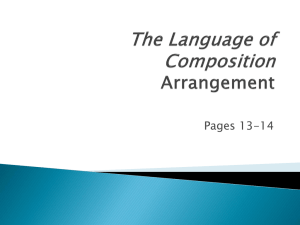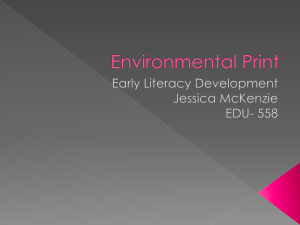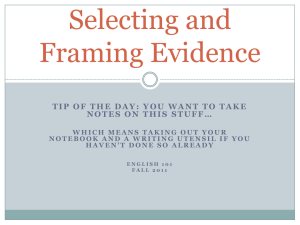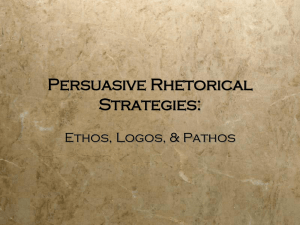philosophical argue
advertisement
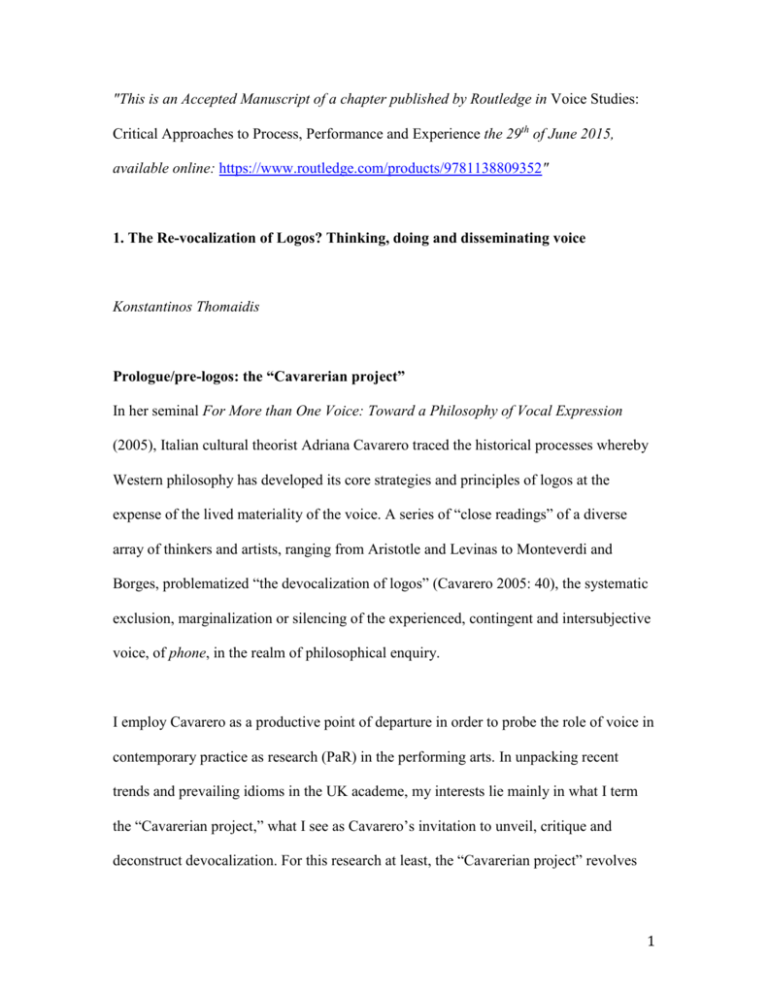
"This is an Accepted Manuscript of a chapter published by Routledge in Voice Studies: Critical Approaches to Process, Performance and Experience the 29th of June 2015, available online: https://www.routledge.com/products/9781138809352" 1. The Re-vocalization of Logos? Thinking, doing and disseminating voice Konstantinos Thomaidis Prologue/pre-logos: the “Cavarerian project” In her seminal For More than One Voice: Toward a Philosophy of Vocal Expression (2005), Italian cultural theorist Adriana Cavarero traced the historical processes whereby Western philosophy has developed its core strategies and principles of logos at the expense of the lived materiality of the voice. A series of “close readings” of a diverse array of thinkers and artists, ranging from Aristotle and Levinas to Monteverdi and Borges, problematized “the devocalization of logos” (Cavarero 2005: 40), the systematic exclusion, marginalization or silencing of the experienced, contingent and intersubjective voice, of phone, in the realm of philosophical enquiry. I employ Cavarero as a productive point of departure in order to probe the role of voice in contemporary practice as research (PaR) in the performing arts. In unpacking recent trends and prevailing idioms in the UK academe, my interests lie mainly in what I term the “Cavarerian project,” what I see as Cavarero’s invitation to unveil, critique and deconstruct devocalization. For this research at least, the “Cavarerian project” revolves 1 around two major axes: the positioning of voice against (traditional, patriarchal and Eurocentric) understandings of logos as reason and of logos as language. Cavarero’s line of enquiry seems to necessitate further probing of the pedagogy and creative praxis of voice: how do we conceptualize voicing? How does voice emerge from and reflect back on its discursive domains? How can we bridge the chasm between ontology and epistemology in the study of voice? Ultimately, how do we think and do voice, particularly within graduate and postgraduate programmes and, by extension, in our explorations as voice practitioner-scholars? This chapter questions the underlying principles that fertilize core concerns around, and approaches to, voice, but recognizes that answers can only be explored fully in practice. Therefore, in examining how institutionalized scholarly activity engages with voice, this chapter investigates the interface between theory and practice in the emerging field of voice studies.1 This analysis extends a post-structuralist interrogation of the knowledge structures embedded in the study of voice in the current landscape of the UK higher education, particularly the dissemination of research into/for/through voice. As such, the analysis— whilst informed by Cavarero’s philosophical argument and primarily concerned with a meta-narrative or metaphysics of knowledge—will be grounded in “case studies” of doctoral projects and their respective publication (and/or assessment) formats. This discussion follows closely both axes of the “Cavarerian project,” mainly concentrating on logos-as-language/dissemination. The overarching aim is of wider relevance, however: I argue for non-hierarchical, less-predictable models of engaging with voice that allow for 2 its phonic element to reclaim its space in epistemological approaches to voice-related research. Devocalizing research: voice versus logos-as-reason/knowledge Unpacking Platonic metaphysics, Cavarero denounced the privileging of thought as the internal, unexpressed and therefore uncontaminated by experience dialogue of the mind with the self. Cavarero is not alone in postulating logos as coinciding with “the mute, visible order of the ideas contemplated by pure thought” (2005: 57). From art and education philosopher John Dewey’s condemnation of a “spectator theory of knowledge” (Quinton 1977: 3) to the recent rise of embodied cognition and somatics, arts practitioners and scholars have contested “[t]he primacy given to the sense of sight,” which “combined with the discovery of perspective as a Western aesthetic, has created distance between the position of the subject and the object” (Reeve 2011: 7). The construction of logos-as-reason on the metaphor of sight is evident in the etymology of a litany of related terms, such as idea (from the Greek idein, meaning to see and to know), theory (from the Greek theorein, meaning to see carefully and to contemplate) or science (from the Latin scientia, meaning to perceive through looking and to comprehend). Metaphors premised on sight, perspective and distance establish theory as a means of spatializing knowledge in a way that hierarchizes the knower over the known (Salmond 1982: 68-70). The constitutive presumption here is that reasoning, and by extension scientific research, involves observing from a distance, clarifying through examination or relating to the sphere of ideas. 3 This is an endeavour often assigned to quantitative approaches to research, which make claims at a “possible degree of separation between the researcher and the researched” (Smith and Dean 2009: 4). Is it possible, however, to research voice—which we thought of as an in-between in the Introduction to this book—only as a measurable, distanced or objectified phenomenon? According to Smith and Dean, “[a]t the basis of the relationship between creative practice and research is the problematic nature of conventional definitions of ‘research,’ which are underpinned by the fundamental philosophical quandary as to what constitutes ‘knowledge’” (2009: 2). Cavarero’s disputation of the mute order of consciousness from the perspective of voice could be deployed to challenge any notion of “knowledge as being an understood given” (Smith and Dean 2009: 3). In considering these comments, and in interrogating knowledge-production processes in the study of voice, I see traditional conservatoire training as fostering a training focused on phone, the embodied knowledge of vocal practice. Logos-as-reason in this instance is tacit (see Polanyi 2009), muted, as it were, but implicit in the bodily disciplining of the vocal apparatus. However, in interrogating paradigms of vocal knowing from a Cavarerian perspective, even established training pedagogies, with their devotion to transmitting a set of canonical works (especially in the realms of opera and musical theatre), can be unpacked as complex, logocentric strategies of disciplining phone into voicing the logos/texts of the repertoire. In undergraduate university programmes, the other prevailing model of vocal education, logos appears to take precedence within units on historical and contextual knowledge of voice (opera studies, musical theatre milestones or poetics and linguistics, to name but a few). Practical units are on offer but, 4 although more frequently than not delivered by practitioner specialists, they can be subject to criticism. Freeman, surveying actor training, warned against the dangers of merely imitating the conservatoire sector: “the links and overlaps between drama schools and non-vocational programmes provide little more than opportunities for boutique borrowing, with each group singing from the same sheet until such time as our innate differences of intent and possibility emerge” (2013: 86). Institutional pressures on timetabling and resources mean that the number of hours devoted to practical voice sessions in degree courses may be significantly less than in conservatories. But should it be different? The problem is one of underlying paradigms; undergraduate programmes, when not explicitly vocational, need neither aspire only to tacit knowledge—nor do they have to aim at purely logocentric analysis. Universities are changing and Nelson’s call for new categories in which “knowing-doing is inherent in the practice and practice is at the heart of the inquiry” (2013: 10) can have a decisive effect on the framings of voice across undergraduate higher education. To revocalize the logos/reason of vocal knowledge, foundational paradigms can be set up and developed in order to embed methodologies constituent to the PaR enterprise more commonly applied at postgraduate/doctoral levels. Crucially, what is at stake is not a mere silencing of logos but a project of re-imagining voicing as praxical and intimately connected to practice and knowledge production.2 Devocalizing dissemination: voice versus logos-as-language/symbol 5 The second component of Cavarero’s criticism relates to logos as a system of signification, to the “side” of logos that “coincides with language” (2005: 57). In the logocentric world, which is premised on a model of communication seen as the exchange of signs, voice—bound to the sonorous component of signifiers—ought to serve the expression of signifieds. Linguist Ferdinand de Saussure conceptualized voice as such: “In any case, it is impossible for sound alone, a material element, to belong to language. It is only a secondary thing, substance to be put to use” (1959: 118). Voice in the process of signification is just a remainder, a leftover, not worthy of much elaboration outside its role as bearer of utterances. In the immaterial universe of signs, language can exist with no connection to corporeality, and signs have no need for voice to exist. In Cavarero’s words, “[t]he voice thus becomes the limit of speech—its imperfection, its dead weight. The voice becomes not only the reason for truth’s ineffability, but also the acoustic filter that impedes the realm of signifieds from presenting itself to the noetic gaze” (2005: 42). Nonetheless, what is it that voice expresses, and how? Is any study of voice destined to investigate language? In an attempt to challenge logos as signification, I will now focus on the dissemination of voice-related research. The previous section mapped some of the challenges with which the Cavarerian critique of logos-as-reason presents existing modes of knowledge-production in undergraduate or conservatoire-type environments. What happens, though, when researchers share their knowledge on a doctoral level? Which systems of signification do they employ, activate or object to? In other words, which is the place of voice, and vocal praxis, in relation to the logos-as-language of scholarly dissemination? For Smith and Dean, the answer seems 6 straightforward when “knowledge is normally verbal or numerical”; however, “[s]ince it is clear that a sonic […] artwork can sometimes transmit knowledge in non-verbal and non-numerical terms, we believe that any definition of knowledge needs to acknowledge these non-verbal forms of transmission” (2009: 3). This section questions the presuppositions and underlying assumptions of existing modes of dissemination. I also discuss the potentialities that a PaR approach can trigger and foster in the field of voice studies (or in related disciplines, when a voice studies approach is employed). Dissemination is taken here as an umbrella term, encompassing not only the various types of public sharing, presentation and publication in the professional arena, but also the broad range of disseminating practices during the educational process, normatively thought of as assessments. A decisive “rite of passage” that links these two worlds is the final assessment of a researcher and, supposedly, the very first sharing of their research in a peer-reviewed context, the viva. Mladen Dolar’s analysis of this moment can further illuminate the tensions between logos and voice/phone. Building on Giorgio Agamben’s observations on the extimate connections between bios and zoe as the core organizational principle of politics,3 Dolar argued that “the voice, in its function as the internal exterior of logos, the apparent pre-logos, the extra-logos, is called upon and necessary in certain well-defined and crucial situations” (2006: 107), such as the ritual readings of the Holy Scripture, the interrogation of witnesses in judiciary processes, and elections. Crucially, in an educational system whereby a university student is mainly expected to engage with 7 various manifestations of logos, primarily through readings, written exams or essay-type assignments, the performative “limen” between being a student and adopting the vocational identity of the researcher is an act of voice; namely, the defense of a doctoral thesis viva voce. The viva is “indeed simply a question of vocal display; the supposed testing and questioning of the candidate’s knowledge has very little to do with that knowledge itself, and has an entirely ritual and vocal character” (Dolar 2006: 110). This is not a mere case of acknowledging the importance of the voice; it is a regulatory process whereby the unruly, ephemeral, I-thou character of the voice (as the equivalent of Agamben’s biological life, zoe) is allocated a strictly delineated space within the educational process. Voice is therefore subordinated to the main object of the examination, the thesis, the research results presented as logos-set-in-stone. To return to Cavarero, this is yet another strategy of devocalizing knowledge, even in its dissemination. However, a PaR approach can open up fresh possibilities as it “offers a clear challenge to conventional thinking in its premise that the practice of performance can be at once a method of investigative research and the process through which that research is disseminated” (Freeman 2010: 7). This challenge extends to the significance afforded to the researcher’s voice in the quasi-ritual tactic of the viva. The assessment—and dissemination—of the practical component of a PaR thesis project could reposition the voice to the forefront and establish new balancing acts between the traditionally accepted logos/thesis and the voice/practice. 8 Having said that, it would be naïve to consider the mere presence of a musical/vocal/sound performance piece as automatically presenting logos with a challenge (or as activating disciplinary resistance, to stretch this logic to its Foucauldian limits). The exigency of disseminating research “in a communicable and retrievable form” (Freeman 2010: 113) can reposition voice in relation to logos in various ways. This section will build on Freeman’s refashioning of Frayling’s (1993: 2) research into, for and through art, in order to map these differing positionings and tensions from the perspective of dissemination. A research into/of practice (RiP) approach addresses the practice as the object of study, with the term “object” bearing all the philosophical complexity 20th-century critical analysis has bequeathed to us (see Böhme 1993). Research projects that offer semiotic analyses of musical theatre pieces or historical and historiographic reflections on compositional processes in the format of a written dissertation, exemplify such an approach. In this instance, despite voice being the central object of study, phone as lived materiality remains a point of reference or material relegated to an appendix. RiP transposes the contingency and impermanence of the voice within systems of logocentric signification. Recent instances of such an approach are Experience Bryon’s (1998) or Konstantinos Thomaidis’s (2013) theses.4 Bryon, for instance, developed a critique of performing strategies and pedagogical models available to the interdisciplinary (voicing) performer, drawing on historical examples and research on deconstructionist models of meaning-making in performance. It is indicative that throughout her doctoral research Bryon’s emerging methodology was conceived as Integrative Performance Theory, 9 whereas during later stages of her studio-based explorations it transformed into Integrative Performance Practice and Theory (2014). In other words, although the doctoral project was informed by practical research and was completed by a professional singer, coach and opera director, vocal practice was used as a necessary point of reference but the mode of submission was the conventional written thesis and the research findings informed subsequent practice. Similarly, my thesis on intercultural voice pedagogies aimed to frame the discursive bodies they produce and documented training fieldworks in the appendix. This appendix also included transcriptions of a workshop session that capitalized on the research findings and proposed a new pedagogical methodology for voice. In both instances, the lived voice was secondary to its discussion and only came decisively to the foreground, structurally, as a side project and, chronologically, as the “afterlife” of the research; what was facilitated instead was logos, a study in voice, a critical analysis that found its most appropriate expression in a monograph-type final submission. Research for practice (RfP) establishes a binary between logos and voice, and, in a way, reverses the paradigm of seeing/observing from a distance; what is being investigated/seen/observed is used as a springboard that informs the practice. Such an approach is geared towards application; a theoretical issue is studied and resolved in discursive terms and the practice exemplifies the proposed critical schemata. For example, a RfP project would encompass the theorization of the ideological nexuses embedded in a particular vocal mannerism or stylistic approach to a piece of repertoire, the deconstruction of latent ideologies through a meta- or extra-generic philosophy, and, 10 finally, the materialization of a practical piece informed by this new knowledge. Zachary Dunbar, for example, devised a musical theatre adaptation of Oedipus inspired by his contextual research on classical theatre and methodological probing of interdisciplinary approaches. In this and similar instances, dissemination is effected both through the text and the practice, but, crucially, the practice is not emerging but predicated on and determined by traditional analysis. Voice is an application of logos, it exemplifies and demonstrates the theoretical research. As Freeman put it, “[t]he practice informs the thesis without ever (despite the efforts of a fearless few) satisfactorily standing as the thesis” (2010: 64; original emphasis). Another pertinent example is Chan E. Park’s thesis (1995) on Korean p’ansori (particularly its extended and reworked form of 2003). Park first investigated this musicotheatrical practice from a joint historiographic and ethnomusicological perspective. In noticing the dangers of current codification, she developed new musical narratives that encompass the modes, rhythms and vocal tropisms of the p’ansori lineage but derive new inspiration from recent stories and use English recitatives alongside Korean sung parts. Significantly, these new performances and scores were presented as the culmination of the project and the conclusion of the argument (Park 2003: 245-76). Her suggested model of cross-cultural/transnational performance came as the direct application of her theoretical examination of the genealogy and aesthetics of the genre; consequently, and even though the comprehensive communication of the argument requires both thesis and practice, voice seems to depend on the needs of the theoretical research and to come as a response to its discoveries. 11 Research through practice (RtP), however, invites the practical component as a partner indispensable to the research process. The theoretical context is not predetermined, and the limits and boundaries between theory and practice are constantly negotiated. As a result, the mode of dissemination accommodates a relationship between the exegetical/written, the practical/creative and the documented in a manner that foregrounds the ineluctable uniqueness of both the project undertaken and its “publication” and embraces the fact that the “‘outcomes’ of artistic research are necessarily unpredictable” (Barrett and Bolt 2007: 3; original emphasis). A fluid, nonlinear, studio-based, laboratory-inspired approach results in an idiosyncratic presentation/publication formula, in which the thesis cannot operate as distinct from the practical work or the plethora of supporting media that proliferate in tight connection to RtP projects (artists’ websites, reflexive blogs, audio-visual DVDs, interactive appendices and the like). A number of theses in the broader area of music theatre result in this idiosyncratic amalgamation of practice and research. Karikis’s project (2005) is a particularly useful example. The introduction stated that “the project embarks on a methodological experiment whose starting point is a ‘multi-vocal’ approach to writing and the simultaneous employment and equal consideration of artistic practice and theory” (Karikis 2005: 10). Building on the hypothesis that voice accords presence, the thesis argued that voice is not a representation of the self but a continuous strategy of identitymaking, a listening out for the self (Karikis 2005: 126). Karikis situated voice at the very 12 centre of his project through a series of strategies. The first half of the written submission, which corresponded to the expected literature review of a conventional thesis, was framed as the transcript of a “domestic lepidopterist” and deployed a pseudoscientific mode of speech; in the second part, the thinking voice was replaced by the empirical voice as Karikis embarked on a walk in the streets of London and charted his vocal reactions to sonic events, discovering this process as constant and never fully reaching a clear distinction between the perceiving self and the environmental acoustics. The writing was presented as a transcript and Karikis highlighted the performative and contingent character of voice by coopting voicing personae rather than seeking recourse to a single or impersonal logos. Logos was further challenged through shifting typefaces and neologisms, which negated the language of dissemination as a rigid system of signification and foregrounded its contingent and arbitrary qualities. Second, the phonic and aural took precedence over the written; the thesis was accompanied by CDs with compositions that exemplified and challenged the ruptures in the acoustic identity that the first half conceptualized. Further, they documented the sonic events without which it would not be possible for the second half to articulate its argument. Karikis also proposed a methodology according to which the text was produced by reading and voicing instead of the silent (muted, in Cavarero’s understanding) act of writing (2005: 31). Most importantly, the CDs included a full reading of the text, voiced by speakers of diverse ethnic backgrounds; this was presented as the main submission, while the text was postulated as secondary. What is significant in this case is that the vocal was pervasive and predominant, the linguistic and textual assisted the practice instead of replicating, studying it or applying its findings, and the mode of dissemination (“exploded” textuality, 13 multi-vocal reading, recourse to vocal personae) was inextricably connected to the core argument on the fragmented and essentially ruptured sense of the acoustic self. This written account, among others, engaged with newly composed musical pieces, sonic materials or training exercises in mutually dependent, fluctuating and dynamic symbiosis. One must not forget, however, that this seemingly ever-expanding field of possibilities operates within the fence lines of given assessment criteria (in the case of university examinations) or models of scholarly publication, which, albeit shifting and adapting, tend to prioritize logos over vocal praxis. Haseman and Mafe cautioned that “[a]round each creative work there is a wide field of possible interpretive contexts and it is in the exegesis that some of these can be delimited. This delimiting act, [...] is seldom comfortably arrived at” (2009: 226). It is perhaps in the field of the “uncomfortable,” of that which is not either a priori prescribed or a posteriori imposed, that the emergent, indeterminate and immediate character of the voice can find its place in the dissemination of research through voice (parallel and in addition to research into or for voice). If logos is to be revocalized—to follow Cavarero—or, if voice is to assume less of a ritual role— to employ Dolar—while also addressing the problematics of research significance in PaR projects, it is imperative to re-imagine dissemination too as a dialogic framework, a nexus of tensions between logos and voice. I will now return to, and further refine, this notion of tension between the practical and the exegetic. Epilogue/epi-logos: PaR as revocalization 14 Yet another question needs to be asked: what is the relation between the two aspects of logos, between language and thought? Cavarero saw “the ideas” as “the origin of both verbal language and the empirical world” (2005: 41). “Thinking and speaking,” “the two components of logos,” are “arranged in hierarchical order” (Cavarero 2005: 57). This implies that “[a]s a specific object of interest for philosophy, the human voice is grasped within a system of signification that subordinates speech to the concept” (Cavarero 2005: 34). It is in the traditional dualism between the vocal/aural and the conceptual/seen that Cavarero located the devocalization of logos, the dichotomy between embodied phonation and critical enquiry—and this dichotomy prioritizes the sign over vocality and the idea over the sign. In the words of Simon Jones, “[o]ur greatest challenge is to find ways—and I stress here the plural, as there may well be as many ways as there are bodies or combinations of bodies active within the academy—of housing the mix of performative and textual practices alongside each other” (2009: 29; original emphasis). In this spirit, and after applying and extending the critique of logos to the study and research of voice, it is timely to ask: which is the alternative that Cavarero proposed? Cavarero, in reading Calvino, called for “a vocal phenomenology of uniqueness” and explained: “This is an ontology that concerns the incarnate singularity of every existence insofar as she or he manifests her- or himself vocally” (2005: 7). It is here, then, that the overarching intentionality of her project is revealed: Cavarero criticized logos in order to reclaim some breathing space for the contingency, temporality, presence, vulnerability and relationality of the lived voice, which she understood as “not being but becoming” (2005: 15 37). In a similar vein, I would recognize that perhaps the ultimate aspiration of this chapter is to define a place for voice within the academy, to find a voice for voice. At a first glance, this may sound as a valorization of practice over research; Bolt seems cautious, however, when diagnosing the risks ingrained in such a claim: “practice-only postgraduate research can disable practice-led research by confusing practice with praxical knowledge and severing the link between the artwork and the work of art” (2007: 33-34). Research and knowledge can be implied in the very act of voicing, but voicing per se is not necessarily the sole enabling a priori of any related research or knowledge. Cavarero too does not seem to advocate a simplistic overthrow of metaphysics in favour of phenomenology; her “project,” as earlier defined, is a philosophical one after all. She rather claimed “a kind of reversal”: “to understand speech from the perspective of voice instead of from the perspective of language” (Cavarero 2005: 14) and to (re)consider how for pre-Platonic thought it was “the phone that decide[d] the physiology of thought” (Cavarero 2005: 63). For this author at least, as a voice studies practitioner-scholar, this shift in perspective is crucial in re-imagining the role of voice in research. However, Cavarero’s propositions seem to imply a methodological scheme of wider interest or application. In the suggested reading of For More than One Voice (2005), voice is not only expressive of logos-asreason, but it also constructs and generates it; equally, voice is not the facilitator of logosas-language, of a supposedly set-in-stone system of signification, but it participates in its 16 shaping and construction. I read Cavarero’s dismantling of devocalization as a critique of a presupposed and essentialist hierarchy between thinking, speaking and voicing. On this basis, and in agreement with Pitches’s argument that “any claim to a singular and expert account of training [or research, I would add] methods or methodologies should be treated with considerable suspicion and skepticism” (2011: 140), I propose an approach to PaR that unfolds as a triangular continuum between logos-as-reason, logos-aslanguage, and practice (which, in the instance of voice studies, is, or involves, voice). This scheme, as evident in Nelson’s triangular, dynamic model for mixed-mode research, mixed-mode practices and “theoretical practices” (2006: 18), can facilitate a multimodal, “mixed” and emerging engagement with the voice. Extrapolating Nicolescu’s triangle of the included middle (2002: 156), what I find particularly intriguing is that each point of the proposed triangular continuum can be seen as operating on a different plane where the other two points can be seen as non-contradictory; if seen as the two points of a line, for example, practice and research are either separated or draw from each other and result in each other (as in the examples of research in voice and for voice). In classical geometry, after all, each point signifies location and points in a line imply opposing directionalities. The third point can provide opportunities for inclusion, complex interaction and noncontradiction. The emerging format of Karikis’s thesis, as shown, challenged the opposition of his vocal practice and (voiced) writing and offered a new plane in which the dissemination allowed for a dynamic, nascent, praxical understanding of voice. 17 Building on my reading of Nicolescu and Nelson, I see this type of triangulation as an ongoing process, as a shifting away from the spatial/visual metaphor of the static shape. This paradigm rejects linear trajectories from logos/thinking towards the conceptualization of practice or, reversely, from practice towards the generation of exegetical logos, and embraces the potential of the “uncomfortable” briefly sketched out in the previous section. In the specific context of “uniqueness” within which its PaR project operates, analysis, praxis and dissemination (including the languages and protocols of sharing at play) are equally generative “partners.” In this case, the major challenge is to maintain each of the three synergetic parameters activated in the dynamic flow between them. If the mode of dissemination is always-already implemented, then logos-as-language is inescapably posited as immobile and hierarchically placed above thinking and practising. For example, if the dissemination is fixed as conservatoire-type exams, voice remains in the predetermined realm of the know-how, whereas if the assessment is always-already in writing, voice is trapped within logocentric dissemination, what Symonds has called “the logocentric archiving of knowledge” (2013: 212). A flexible, contingent and unique thesis/assessment formula could maintain the inventive and unexpected dialogues between logos and practice. As a self-reflective aside, if this analysis of vocal PaR is predestined to be published as a chapter, can it achieve more than making a theoretical claim and proposing a schema, a desire for the praxical possibilities of a triangular continuum to be fulfilled elsewhere? More importantly, this scheme, which, I am aware, comes as a cadence to a rethinking of Cavarero’s work and needs further expansion to gain currency in its own right, does not only encapsulate a call for a revocalization of logos. It also points to the reverse side of 18 the coin, that the revocalization of knowledge cannot come at the expense of the delogosization of practice. References Barrett, E. and Bolt, B. (eds) (2007) Practice as Research: Approaches to Creative Arts Enquiry, London and New York: I.B. Tauris. Böhme, G. (1993) “Atmosphere as the fundamental concept of a new aesthetics,” Thesis Eleven, 36(1): 113-26. Bolt, B. (2007) “The magic is in handling,” in Barrett, E. and Bolt, B. (eds) Practice as Research: Approaches to Creative Arts Enquiry, London and New York: I.B. Tauris, 27-34. Bryon, E. (1998) The Integrative Performance Theory: An Anti-Hermeneutic Approach for Opera, Ph.D. thesis, Victoria: Monash University. --- (2014) Integrative Performance: Practice and Theory for the Interdisciplinary Performer, New York: Routledge. Cavarero, A. (2005) For More than One Voice: Toward a Philosophy of Vocal Expression, trans. P.A. Kottman, Stanford: Stanford University Press. Dolar, M. (2006) A Voice and Nothing More, Cambridge, MA: MIT Press. Dunbar, Z. (2007) Science, Music and Theatre: An Interdisciplinary Approach to the Singing Tragic Chorus of Greek Tragedy, Ph.D. thesis, London: University of London. 19 Frayling, C. (1993) “Research in art and design,” Royal College of Art Research Papers, 1(1): 1-5, http://www.transart.org/wp-content/uploads/groupdocuments/79/1372332724-Frayling_Research-in-Art-and-Design.pdf. Freeman, J. (2010) Blood, Sweat and Theory: Research through Performance, Faringdon: Libri Publishing. --- (2013) “Performance studies, actor training and boutique borrowing,” Studies in Theatre & Performance, 33(1): 77-90. Haseman, B. and Mafe, D. (2009) “Acquiring know-how: research training for practiceled researchers,” in Smith, H. and Dean, R.T. (eds) Practice-led Research, Research-led Practice in the Creative Arts, Edinburgh: Edinburgh University Press, 211-28. Jones, S. (2009) “The courage of complimentarity: practice-as-research as a paradigm shift in performance studies,” in Allengue, L., Jones, S., Kershaw, B. and Piccini, A. (eds) Practice-as-Research in Performance and Screen, Basingstoke and New York: Palgrave Macmillan, 19-32. Karikis, M. (2005) The Acoustics of the Self, Ph.D. thesis, London: UCL. McAllister-Viel, T. (2006) Toward an Intercultural/Interdisciplinary Approach to Training Actors’ Voices, Ph.D. thesis, Exeter: University of Exeter. Nelson, R. (2006) “Modes of PaR knowledge and their place in the academy,” 1-23, https://www.westminster.ac.uk/__data/assets/pdf_file/0011/74594/RobinNelson.pdf . --- (2013) Practice as Research in the Arts: Principles, Protocols, Pedagogies, Resistances, Basingstoke and New York: Palgrave Macmillan. 20 Nicolescu, B. (2002) Manifesto of Transdisciplinarity, trans. K-C. Voss, Albany: State University of New York Press. Park, C. (1995) P’ansori Performed: From Strawmat to Proscenium and Back, Ph.D. thesis, Hawai’i: University of Hawai’i. --- (2003) Voices from the Straw Mat: Toward an Ethnography of Korean Story Singing, Honolulu: University of Hawai’i Press. Pitches, J. (2011) “Performer training: researching practice in the theatre laboratory,” in Kershaw, B. and Nicholson, H. (eds) Research Methods in Theatre and Performance, Edinburgh: Edinburgh University Press, 137-61. Polanyi, M. (2009) The Tacit Dimension, Chicago: University of Chicago Press. Prior, R. (2012) Teaching Actors: Knowledge Transfer in Actor Training, Bristol: Intellect. Quinton, A. (1977) “Inquiry, thought and action: John Dewey’s theory of knowledge,” in Peters, R.S. (ed.) John Dewey Reconsidered, London: Routledge, 1-17. Reeve, S. (2011) Nine Ways of Seeing a Body, Axminster: Triarchy Press. Salmond, A. (1982) “Theoretical landscapes: on cross-cultural conceptions of knowledge,” in Parkin, D. (ed.) Semantic Anthropology, London: Academic Press, 64-87. Saussure, F. (1959) Course in General Linguistics, trans. W. Baskin, New York: Philosophical Library. Smith, H. and Dean, R.T. (2009) Practice-Led Research, Research-led Practice in the Creative Arts, Edinburgh: Edinburgh University Press. 21 Symonds, D. (2013) “‘Powerful spirit’: notes on some practice as research,” in Symonds, D. and Karantonis, P. (eds) The Legacy of Opera: Reading Music Theatre as Experience and Performance, Amsterdam and New York: Editions Rodopi, 209-28. Thomaidis, K. (2013) The Grain of a Vocal Genre: A Comparative Approach to the Singing Pedagogies of EVDC Integrative Performance Practice, Korean Pansori, and the Polish Centre for Theatre Practices “Gardzienice,” Ph.D. thesis, London: University of London. 1 This research first appeared in Studies in Musical Theatre. I thank the editors for granting me permission to publish this reworked version. My ongoing collaboration with Amanda Smallbone and Ben Macpherson at the Centre of Interdisciplinary Studies has been central to the development of this chapter. 2 In this volume, McAllister-Viel and Smallbone reflect further on voice training within undergraduate courses. 3 For Agamben, the Greek term zoe denotes life as a biological phenomenon and bios refers to socio-political coexistence. Their connection is extimate in that bios, the structured life of the polis, orders and marginalizes zoe but inevitably, the natural life of instincts and biological needs remains at the very centre of human activity. Dolar elaborated on the concept of extimacy in seeing logos as the structured system of signification, the organized language of the social order, and voice/phone as the suppressed, controlled but unavoidably present equivalent of zoe (2006: 119-24). 4 I do not intend to compare or evaluate the significant contributions to knowledge effected through the selected theses; the emphasis is on the mode of dissemination, 22 understood within specific knowledge-making paradigms and therefore assessment criteria and corresponding institutional standards. 23

